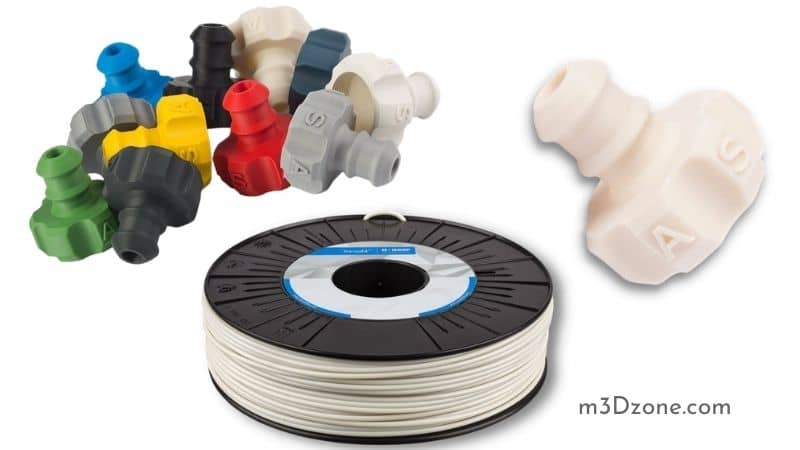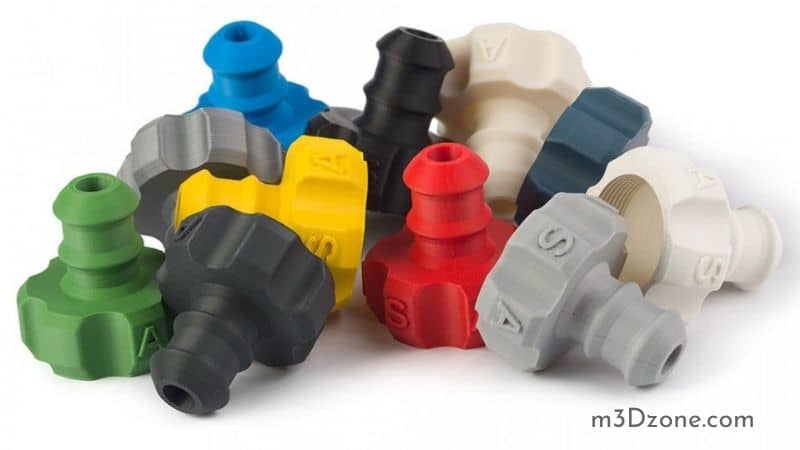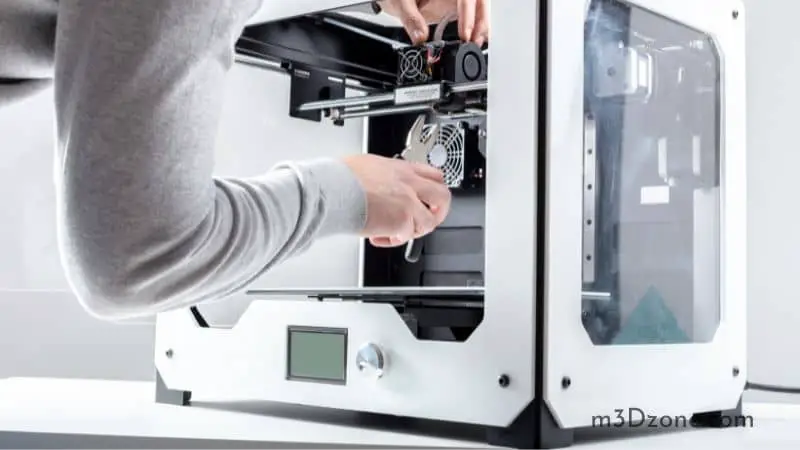Acrylonitrile Styrene Acrylate (ASA) filament is a printable thermoplastic material with properties similar to those of Acrylonitrile Butadiene Acrylate (ABS) plastic filaments.

It serves as an alternative to ABS as it’s designed with more UV-resistance qualities. To attain the UV- resistant qualities, the manufacturers use a different rubber in its formulation.
Quick Navigation
In the 3D printing industry, ASA uses remain varied and numerous. Because of its superior resistance to UV and harsh weather conditions, it’s preferred for outdoor applications instead of ABS plastic filament.
In 3D printing, ASA plastic filament is used to print automotive exterior parts, housing components, sporting goods, external signages, pieces of equipment, garden equipment, and outdoor parts and fixtures.
What Is Asa 3D Filament?
ASA refers to Acrylonitrile Styrene Acrylate. It’s a thermoplastic filament material used in 3D printing and enjoys numerous qualities that make it ideal for engineering and outdoor use.
As an improved version of the more popular and widely used ABS filament, ASA provides users with many benefits of ABS minus some significant drawbacks.
ASA Prints
ASA, like its cousin the ABS, proves a little difficult to print. The printing difficulty is occasioned by ASA’s sensitivity to heat while being printed. However, after printing, ASA print remains quite a heat-resistant and durable product.

ASA prints prove rigid and more robust compared to the ABS prints. Therefore, the tensile strength of ASA filaments seems more potent than that of the ABS filament.
Notably, while ABS prints tend to turn yellow when left outside, ASA prints do not.
Pros and Cons of ASA Filaments
As a 3D printing hobbyist, you might be interested in 3D printing using the ASA plastic filament. Therefore, it may be pretty helpful to know what ASA can be used for as well as reasons you might want to try it out or not.
Pros
- Strong UV resistance
- Strong chemical resistance
- Water resistance
- Post-processing capabilities with acetone
- High Impact resistance
- Tough
- Durable
- Good finish
- Anti-static
Cons
- Release dangerous fumes
- Expensive compared to other 3D printing filaments in the market
- Higher extruder temperatures
- High printing energy consumption
- Parts may crack
- Parts may warp and sink
How to 3D Print With ASA Filament
As you consider using ASA filament for your 3D printing, ensure your 3D printer meets these hardware requirements for optimal print quality.
-
Heated Bed
ASA tends to shrink and crack due to the temperature difference between the nozzle and the surrounding air. Therefore, you may need to be vigilant on the nozzle distance from the print bed to avoid this mishap.
Otherwise, thermal deformation caused by this disparity creates internal tensions that cause printing challenges.
High-temperature heated beds are ideal for printing high-temperature plastics. The heated beds can reach a temperature of 100ºC in just 80 seconds, highlighting the need to have mechanical properties to control their temperature.
-
Build Surface
The build surface is made consistent among other material parts of the pet sheet. That makes for a good build surface layer.
ASA filament 3D prints well in a 3D printer with proper bed adhesion. You will find many solutions in the 3D printing industry for adhesion issues. However, the most widely used solutions include using Kapton tape, coating solutions like glues, or even standard hair spray.
Notably, you need to ensure you have a well-leveled bed surface before you start printing.
-
An Enclosed Printer
When 3D printing using ASA filaments, you need to use an enclosure.

Moreso, when you’re printing larger prints, unlike smaller prints. Larger models produce a lot of residual stress that can easily cause cracking and delamination, causing poor 3D prints.
An enclosure protects the 3D printer from drafts that cause parts to warp, and it also protects people from potentially dangerous fumes emitted.
-
High-Temperature Hot End
PTFE-lined hot ends may not be suitable to print ASA for prolonged periods since it starts degrading at 2500C.
While some ASA filament brands can be printed at higher glass transmission temperatures, ASA filament brands may be printed with temperatures lower than 250 0C. Therefore, an all-metal hot-end is the safer choice.
After meeting the hardware requirement, the next thing to do will be to fine-tune the printing settings.
-
Bed Temperature
ASA build plate temperatures range between 90-1100C depending on the filament ASA brand. All filament manufacturers usually specify specific bed temperatures to adhere to for different ASA filament brands.
High Glass Transition Temperature
Going beyond or printing at a higher glass transmission temperature than the one specified will cause severe problems with the printing process. The plastic filament will not withstand the temperatures and degrade.
-
Nozzle Temperature
The nozzle prints at a high adjusted temperature range of 240 – 2600C. Interestingly, printing too hot is recommended for ASA than printing cool because printing at a higher temperature provides better adhesion, which aids excellent 3D print quality.
-
Cooling
No cooling settings need to be done for ASA printing. You may leave it off to cool. However, very low speeds like 5 to 10% might improve overhangs and overall print quality.
What Is ASA Filament Good For?
Let’s see what can you use 3d ASA filament for.
3D Printed Tools
ASA, being an affordable 3D printing material, demonstrates good mechanical performance and resistance to the elements.
Ii can be used to provide work holding jigs and fixtures, end of arm tooling (EOAT), inspection gauges, and assembly fixtures.
3D Printed Prototypes
Due to its strength properties and UV resistance, ASA can produce functional prototypes such as molded components for Auto, Marine, and RV applications.
Electrical housings, outdoor appliances, hand and power tools, sporting goods, and exterior signage.
Is ASA Easy to Print?
3D printing with ASA is easier compared to the ABS. However, it can have its difficulties as it remains sensitive to temperature changes that negatively impact print quality.
The two most pressing issues surrounding printing with ASA can be identified as the object or print warping and emission of dangerous fumes.
-
Print Warping
Warping happens when parts of the print fail to cool evenly. A lot of information abound on avoiding distortion during an FDM printing process, mainly with ABS. Since ABS and ASA enjoy similar material qualities, you may follow the same recommendation to prevent warping in ASA.
To do so, avoid wind drafts, ensure an excellent first layer adhesion, keep your printer calibrated, and you may use brims or drafts as a last resort.
-
Dangerous Fumes
Most printing materials in the 3D printing industry emit some harmful substances during extrusion. ABS emits both dangerous gaseous molecules and nanoparticles due to the raw materials used to make them.
However, as much as ABS and ASA may have almost similar water-soluble support materials, ASA remains less troublesome to print among the two.
Nonetheless, ASA can also be very smelly due to the existence of styrene in it. The solution may be to use proper ventilation and a face mask to mitigate these dangerous fumes. The use of air filters may also come in handy.
Is ASA Filament Toxic?
ASA filament has exceptional dimensional stability and exceptional chemical resistance. It’s made of thermoplastic materials, just like its cousin, the ABS. It means, ASA filament also emits toxic fumes during the printing process, just as ABS.
It may be a good idea to print using ASA filament in a spacious and well-ventilated area. Otherwise, the use of a printer enclosure may be quite valuable during the printing process.
If you print sizeable 3D print models using ASA, you may consider setting up an elaborate air ventilation system using an air quality monitor.
The air quality monitor helps minimize health risks resulting from potentially dangerous toxic fumes by providing you with information on air quality.
Thus, with such information, you may act appropriately to mitigate poisonous fumes in your printing space.
Is ASA Better Than ABS?
ASA and ABS have similarities in quality and composition to the effect that they may be considered cousins. ASA proves to be a true successor of ABS. as its development was designed to improve significantly the qualities seen in ABS.
So, indeed ASA is the better filament when compared to ABS.
Herein, find some of the essential qualities that distinguish ASA from ABS and even other well-known printing filaments such as PLA and PETG.
- UV stable
- Produce less noticeable fumes
- Durable prints
- Suitable for a wide range of applications
- The glass transition temperature is higher than in PLA and PETG
- Detailed prints without a stringing effect
- You can smooth it with acetone vapor
- Easily sanded post-processing
- Tough, high impact, and wear
- Recyclable
Is ASA Stronger Than PLA?
ASA has many similarities to ABS, to the extent that it is considered a cousin to the ABS. Thus, ABS was improved by facilitating the ASA development. The ABS, as such, retains a lot of qualities of the ABS and adds more rates that enhance the ABS.
PLA remains a more robust thermoplastic filament compared to the ABS and, by extension, the ASA.
PLA is a user-friendly thermoplastic with a higher strength than ABS that has similar qualities to the ASA.
With a low melting temperature and minimal warping, PLA remains the easiest material to 3D print. Its low melting point enables it to lose all stiffness and strength at a temperature of 50ºC. PLA has brittleness that leads to printed parts with poor durability and impact resistance.
Among the two, ASA remains weaker and less rigid compared to PLA. However, it’s a tougher, lighter filament and more suitable for applications beyond hobbyists.
ASA and ABS are more durable than PLA, 25% lighter, and enjoy four times higher resistance.
Conclusion
The 3D printing community enjoys numerously and suitable3D printing filaments to pick in the market depending on printer needs.
PLA, ABS, and PETG are some of the most popular with customers and 3D printing hobbyists. The article introduces one of the least known thermoplastic filaments, the ASA, to 3D filament users.
ASA has similar qualities to ABS and was introduced in the market to improve on the ABS ostensibly. Therefore, it comes out as a real improvement to the ABS filament qualities, and users who are used to the ABS will enjoy added qualities in ASA.
Recommended Reading
TPU vs PETG. Pros, Cons, Basics, Comparisons.
TPU vs PETG. When comparing TPU and PETG, you'll find differences. So you need to pick the filament that will suit your unique 3D printing needs. Let's see!
How to Make a 3D Model From a Picture in 5 Easy Steps
How to make a 3D model from a picture in 5 easy steps! With a few practice runs, you will be able to quickly turn any 2D pictures into 3D objects. Let's see!
What Software Do I Need for 3D Printing?
While working with 3D printers a very common question arise: What software do I need for 3D printing? Which is the best one? I got you covered. Let's dive in!
